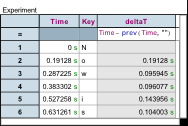Typing Tutor Experiment
Have you ever wondered which keys on a computer keyboard give you the most trouble? For example, which take you the longest to reach? In this tutorial, you’ll use Fathom to find out. You’ll turn a collection into an experiment that records which keys you type and how long it takes you to type them.
This tutorial assumes you know how to make case tables and graphs.
Making a Timer and Connecting It to a Collection
To do an experiment, you start with a collection.
1. Drag a collection from the shelf to your document.
2. With the collection selected, from the Collection menu choose Create Experiment.

Notice that the name and icon of the collection change to reflect that you now are using the collection as an experiment. The collection’s inspector opens to the Experiment panel, ready for you to change the experiment’s setup and turn the experiment on.
3. Choose the Keypress radio button.
You’re now ready to start the experiment. You need something to type, of course. Choose a paragraph of normal text and make yourself comfortable.
4. Press the Turn Experiment On button.
5. When you’re finished press the Turn Experiment Off button.
The experiment collection now contains one case for each keypress.
6. Make a case table for the collection.
7. In order to determine which keys take the longest for you to type, you need a new attribute, one that computes the time from the previous keystroke to the current one.
8. Define a new attribute, deltaT, with the formula: Time – prev(Time, “”)
9. Make a graph of Key versus deltaT.
10. Plot the mean of the deltaT’s.
11. Sort the categories of Key by the plotted value. (With the graph selected, choose Graph | Sort by Plotted Value.)
Your graph may look similar to the one shown at right. Do you have any particular problem keys?
Explore More
- Try the experiment again either by deleting all the data and starting over or by adding more data to the existing experiment. (You’ll probably get an outlier for the first new case. Fix that by deleting its time.) Are the two sets of data consistent?
- Does your key speed depend on which row of the keyboard a given key is in? (You’ll need to figure out how to calculate the row for each case.)
- Similarly, does one hand type faster than the other? (If you’re familiar with statistical inference, this might be an opportunity to use it!) Are some fingers faster?
- What about pairs of keypresses? Does having to use one finger to type two consecutive letters (as in the first two letters of love) slow you down?
- Use your data to estimate your typing speed in words per minute. Do this both on a per character level and as an average over the entire collection. Does the average of the instantaneous speeds equal the overall average?
